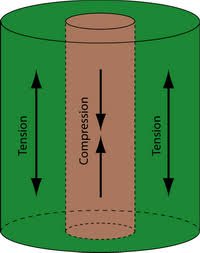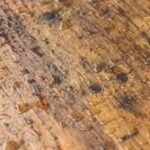Wood is a special material and has been favoured by builders and construction specialists since time immemorial due to its high resilience and flexible forms.
Before the invention of steel and other forms of metal construction, most buildings were made with wood structures and even today, America owns a majority of wooden homes.
Wood is generally strongest in Compression compared to tension.

You may be confused as to what these are, well they are forms of wood formed when the wood is grown to have special features. This type of wood is primarily called reaction wood. This is because the wood is formed as a reaction to several environmental factors such as wind, pressure, climate, gravity etc. These Special growth patterns are usually witnessed on the branches and trunks of the trees being grown and it’s easy to identify them because of the stress formations that are formed on them. There are two major types of reaction wood which are the ones we would be focusing on today:
- Compression wood
- Tension wood

The main difference is compression wood is reaction wood of conifers while tension wood is reaction wood of dicots.
Compression Wood
Compression wood the stronger type of reaction is wood is formed in conifers specifically on the lower side of the trunks. It is usually formed in trees with high lignin content hence its high compression ability. This type of wood can also be formed in branches of conifers, typically on the underside of the branches. Compression wood does not usually contain pith at the centre but higher. Compression wood prevents progressive bending and cracking in the branches of these trees, without its formation, trees would break at the slightest pressure. Compression wood is usually formed on that side of the branch which bears the most pressure and thereby helps in lengthening and straightening the bend. Compression wood is mostly focused on being strong and withstanding pressure hence it has a low cellulose content of just 30% which is very low compared to the normal cellulose content of both normal wood and tension wood. It helps in maintaining the angle of bending, providing more strength and is favoured by builders for these exact qualities.
Tension Wood
Unlike its counterpart above, tension wood is formed in trees of dicotyledonous nature. It’s mostly formed on trees that are leaning or bent as a natural mechanism to prevent breakage. It contains more cellulose than compression wood hence it can withstand effectively and resist leaning or bending. Trees like oaks form tension wood in them on the upper side of the branch to prevent the branch from drooping or bending. Once this is done they start to develop more wood on the underside to offset this weight. Tension wood has a higher amount of cellulose than normal wood and compression wood with its cellulose content at around 60%.
Differences
- angiosperms form tension wood and gymnosperms form compression wood.
- Compression wood is formed on the lower side of the trunk while tension wood is formed on the upper side of the trunk, this is where loggers mostly check to identify which type.
- Compression wood is rich in lignin while tension wood is rich in cellulose, with the latter having as much as double the cellulose content of the first.
- Compression wood is formed in conifers while Tension wood is formed in dicots.
How do you increase the strength of wood?
A wood hardener is the best option for this as typical wood strengthening products don’t satisfy demands. Like Polycryl. Most wood hardeners are not water-soluble and function to make the wood more durable and strong in the long run, but the thing to note is that they tend to work on wood that has stayed quite old.






